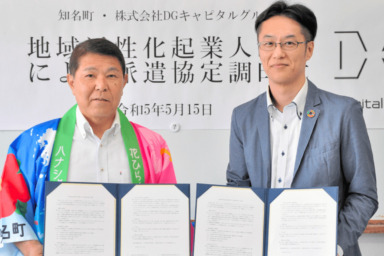
DG Capital Group signed an Agreement with China-cho (Okinoerabu Island)
Left: Town Mayor Rikio Imai
Right: President Masaru Shinkai
DG Capital Group Co., Ltd. (Head Office: Nagoya-chi, President: Masaru Shinkai) and China-cho, Kagoshima (Town Mayor: Rikio Imai) have signed an agreement for the deployment of “Regional Revitalization Entrepreneurs for China-cho”. Utilizing the Ministry of Internal Affairs and Communications' Regional Revitalization Entrepreneurship Program (Corporate Talent Dispatch Program), we signed up the basic agreement on May 15, 2023.
In accordance with this agreement, DG Capital Group would send a staff to China-cho in June. He will relocate to China-cho and engage in tasks related to problem-solving and promotion of decarbonization initiatives, utilizing their specialized knowledge.
Contents of the Agreement
Period of Dispatching
From June 1, 2023, to May 30, 2025
Job Description During the Dispatch Period
- External communication for DGR explanation and document support (Environmental Ministry, Prefecture, Town Council)
- DGR explanation and document support for residents
- Advising on the island-wide renewable energy implementation
- Any other necessary tasks
*DGR: Digital Grid Router
Historical Development of China-cho
The historical classification of the history of Amami is as follows: the period from prehistoric times to the 8th to 9th centuries is referred to as the "Amami Era," a time of tribal communities before the class-based society. It is followed by the "Anji Era," where chiefs known as "Anji" ruled. Subsequently, there was the "Naha Era," under the rule of the Ryukyu Kingdom, and the "Yamato Era," under the control of the Satsuma Domain.
The "Naha Era" lasted for over 340 years from the 3rd year of Bun'ei (1266) to the 14th year of Keicho (1609). During this time, the Ryukyu Kingdom was divided into three dynasties: Nakayama, Kitayama, and Minamiyama, with the main island under the rule of Kitayama. The cultural heritage, language, customs, and traditions passed down on the main island have their origins in this period.
In the 14th year of Keicho (1609), as a result of the invasion of Ryukyu by the Satsuma Domain, the island also became a direct territory of the Satsuma Domain. In the 2nd year of Genwa (1616), a magistrate was placed on Tokunoshima to oversee and govern our island and Yoron Island. In the 3rd year of Genroku (1690), the magistrate's administration was relocated to Okinoerabu Island, and in the 2nd year of Meiji (1869), it was renamed the "Zaikansho" (Subprefecture). With the abolition of the feudal domain system in the 4th year of Meiji (1871), it became the Okinoerabu Branch Office.
In the 12th year of Meiji (1879), the position of "tonaga" (headman) was established, and in the 21st year (1888), China Village Office was established. In the 41st year of Meiji (1908), the Island Village-Town System was implemented, dividing our island into China Village and Wadomari Village.
In the 9th year of Taisho (1920), the general Village-Town System was established, and the village head was elected by the residents. In December of the 16th year of Showa (1941), World War II broke out, and although it ended in August of the 20th year of Showa (1945), due to the San Francisco Peace Treaty in the 21st year of Showa (1946), our island was administratively separated from mainland Japan and placed under the control of the United States. In September of the 21st year of Showa (1946), the town system was implemented under U.S. military administration.
On December 25, 1953 (the 28th year of Showa), with the signing of the Dulles Declaration, our island returned to the homeland of Japan and started anew as Japanese citizens. In the following year, the Amami Islands Reconstruction Special Measures Law was enacted. Until the 38th year of Showa (1963), reconstruction projects, mainly in public civil engineering, were carried out. From the 39th year of Showa (1964) to the 48th year of Showa (1974), industrial infrastructure development was promoted, and from the 49th year of Showa (1975) to the 10th year of Heisei (1998), social infrastructure development was pursued through development and promotion projects. This laid the foundation for the town.
Since the extension of the Special Measures Law until the 15th year of Heisei (2003), comprehensive development efforts are being made to promote the development of a "rich, bright, and comfortable town" while efficiently utilizing the available resources.
Population: 5,564 (As of May 1, 2023)
Area: 53.29 square kilometers

